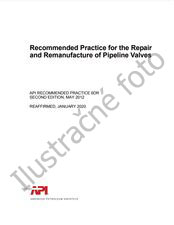Potrebujeme váš súhlas na využitie jednotlivých dát, aby sa vám okrem iného mohli ukazovať informácie týkajúce sa vašich záujmov. Súhlas udelíte kliknutím na tlačidlo „OK“.

API RP 14FZ-ed.2
Recommended Practice for Design, Installation, and Maintenance of Electrical Systems for Fixed and Floating Offshore Petroleum Facilities for Unclassified and Class I, Zone 0, Zone 1, and Zone 2 Locations
NORMA vydaná dňa 1.4.2020
Informácie o norme:
Označenie normy: API RP 14FZ-ed.2
Dátum vydania normy: 1.4.2020
Kód tovaru: NS-1140009
Počet strán: 188
Približná hmotnosť: 595 g (1.31 libier)
Krajina: Americká technická norma
Kategória: Technické normy API
Anotácia textu normy API RP 14FZ-ed.2 :
API RP 14FZ, 2nd Edition, May 2013 - Recommended Practice for Design, Installation, and Maintenance of Electrical Systems for Fixed and Floating Offshore Petroleum Facilities for Unclassified and Class I, Zone 0, Zone 1, and Zone 2 Locations
This document recommends minimum requirements and guidelines for the design, installation, and maintenance of electrical systems on fixed and floating petroleum facilities located offshore. For facilities classified as Division 1 or Division 2, reference API 14F. These facilities include drilling, producing and pipeline transportation facilities associated with oil and gas exploration and production. This recommended practice (RP) is not applicable to Mobile Offshore Drilling Units (MODUs) without production facilities. This document is intended to bring together in one place a brief description of basic desirable electrical practices for offshore electrical systems. The recommended practices contained herein recognize that special electrical considerations exist for offshore petroleum facilities. These include:
- a) inherent electrical shock possibility presented by the marine environment and steel decks;
- b) space limitations that require that equipment be installed in or near hazardous (classified) locations;
- c) corrosive marine environment;
- d) motion and buoyancy concerns associated with floating facilities.
This RP applies to both permanent and temporary electrical installations. The guidelines presented herein should provide a high level of electrical safety when used in conjunction with well-defined area classifications. This RP emphasizes safe practices for hazardous (classified) locations on offshore petroleum facilities but does not include guidelines for classification of areas; for guidance on the classification of areas refer to API 505.
Advantages of area classification using zones are as follows.
Often, particularly for new installations and for installations that are subject to upgrade or revision, it is advantageous to classify locations as “Zones” in accordance with Article 505 of the NEC versus “Divisions” as per Article 500. These advantages may include reduced initial capital expenditures, enhanced safety, or facilities that are more easily and more economically maintained.
In the Zone classification system, locations classified as Division 1 in the Division classification system can now be classified and further divided into Zone 0 and Zone 1 locations. Electrical equipment suitable for Zone 1 locations is not required to be suitable for locations where flammable gases and vapors may be present continuously or for long periods of time, i.e. Zone 0 locations. Thus, the protection techniques for equipment to be installed in Zone 1 locations can be less demanding than the protection techniques for equipment to be installed in Division 1 locations. This may result in more cost effective installations or equipment that is more easily maintained.
Due to the application of increased safety (protection Type “e”) equipment, fewer field-installed sealing fittings are required for Zone 1 and Zone 2 equipment than for Division 1 and Division 2 equipment. Fewer fieldinstalled sealing fittings reduce the chance for installation errors, enhancing safety. Much of the equipment approved for Zone 1 and Zone 2 uses plastics (versus metals), reducing corrosion, which can result in reducing maintenance costs and enhancing safety. Also, since the most hazardous locations (Zone 0 locations) are identified, such locations can be avoided for the installation of most electrical equipment. This also can enhance safety.



 Cookies
Cookies
